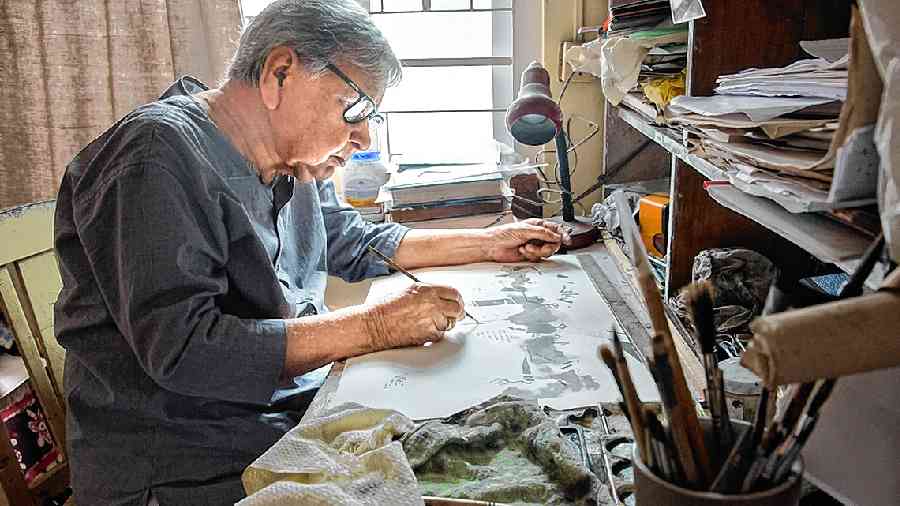Platform No. 12, Howrah station. That was Ganesh Haloi’s residential address when he joined the Government College of Art and Craft, Calcutta, in 1951. Looking at Ganesh Haloi’s upwardly mobile careergraph that has risen slowly but steadily over the years, one cannot help wondering how a dispossessed and destitute refugee, who had left his home in Jamalpur, now in Mymensingh, Bangladesh, in 1950 to escape sectarian violence, became one of India’s leading artists whose exhibitions have been held at some of the most prestigious international venues like the Berlin Biennale 2014, and document a 14 held at Athens, Greece, and Kassel, Germany, in 2017.
The gentle and soft-spoken 86-year-old artist, who has recently recovered from illness, said in an interview with The Telegraph: “Like thousands of other people in a similar condition I could have just disappeared. My willpower grew out of my utter helplessness. And I had a tremendous desire to paint. The mahajans used to lend money and like many others I would buy rice at lower rates at Rampurhat and Pakur and carry the sacks to Rajmahal where my family along with other refugees were dumped without much hope of rehabilitation. I lacked the strength yet I bore half-maund gunny sacks of rice on my shoulders to be sold at higher prices in Rajmahal. That’s how I saved some cash. Who would give me money otherwise? I still practised painting with the paper, paints and brushes and the jackfruit wood board I had brought from home. A Bengali officer from Patna in charge of rehabilitation had encouraged me to practise and join an art course on the refugee quota. So I decided I must join an art college by any means.
“I went to Santiniketan and met Nandalal Bose. But spending Rs 75 per month on board and lodging was beyond my means. I left my family behind at Mokama and came to Calcutta. My mother sold her last pieces of gold for Rs 30 for my transport expenses. Howrah station became my home. My fellow refugees shared their food with me.”
When he started attending classes, often on an empty stomach, he used to sleep in the Burrabazar gaddi of Kripashankar Dikshit, who was an acquaintance of Haloi’s father, a small-time jute trader. His father died young, at 46 of malaria, when the artist was in Class IV.
Haloi says in keeping with Rabindranath’s verse, he never prayed for protection from danger, but for fearlessness in the face of danger.
When he was posted in the Ajanta caves by the Archaeological Survey of India in 1957, he had the Sanchayita and The Life of Buddha for company. “So great was my desire to paint that I would paint without ever sparing a thought for the nature of art. That came later. I painted secretly and kept things close to my chest. If someone appreciated it I felt encouraged. I cannot explain why I gradually changed from figurative to abstract. I don’t look the way I did in my youth but inside I remain the same.
“The verdant and highly humid environment to which I once belonged in Jamalpur never left me. To desert people all that greenery and sheets of water would be like heaven on earth. Even in the early 1960s, when I was already married, Jamalpur would return in my dreams. I couldn’t sleep. It was attached to me like the umbilical cord. I could smell the scent of the pomelo. Our home was on the verge of the mighty Brahmaputra. The river used to swell during the monsoon. In winter, a sand bank reared its head. Jhau trees would shoot up and brown hare scampered around.
“We had some arable land on the other side named Pakshimarir Charand I would often tow a boat laden with the vegetables. In winter, when the water became shallow, the ripples caused by the breeze would create wavy designs on the wet sand. Those patterns caught my eye and they keep returning to my paintings.”
After he was uprooted from his homeland, where the violence was escalating, Haloi remembers the unmistakable stench of death, disease and phenyl in the refugee camps. It was safer in India but death was inescapable. Skeletal remains of children were scattered in the ditches, and dogs fought over carcasses.
Yet, the shadow of death never darkens the beautiful light that permeates his paintings. Nor does it disturb the deep solitude and calm that prevails in them. The artist soars like a bird and observes the lie of the land — the rectangles of the paddy fields, the bodies of water, the meandering rivers. Then he picks out tiny details — a creeper, the waves, an aquatic plant, a solitary kite — and adds them in the fields of colour, conjuring up the harmony of the natural world laid out beneath him. As an artist, Ganesh Haloi seems to remain unperturbed by the catastrophe he had witnessed. Why did it not impact his work?
Says Haloi: “When a man falls down, it is my duty to give him a hand and lift him up. Everything has a limit. Pain has its limit. One can die of starvation but one does not feel the pangs of hunger then. When pain reaches its peak of intensity, one does not feel it any longer.”
Perhaps the artist has reached beyond that.











